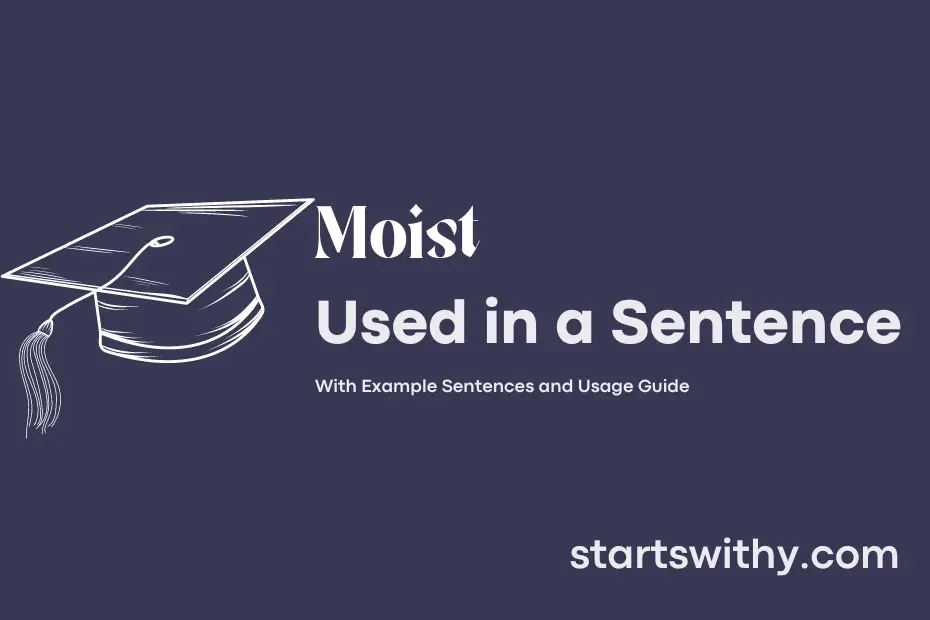Have you ever struggled to find the right word to describe something slightly wet or damp? Look no further, as I introduce you to the term “moist.” This word is commonly used to express the sensation or state of a surface or object that is slightly wet, damp, or not completely dry.
“Moist” can be a helpful descriptor when discussing anything from baked goods to the weather. Its use allows for precise communication and adds a vivid quality to your descriptions. So, next time you need a word to convey a slight dampness, consider using “moist” to paint a clear picture for your audience.
7 Examples Of Moist Used In a Sentence For Kids
- The moist soil helps plants grow big and strong.
- After it rains, the ground feels moist to touch.
- When you bake a cake, the batter should be moist but not too wet.
- Please water the plant so the soil stays moist.
- The air near the river is usually very moist.
- Be careful not to step in any moist puddles after the rain.
- The fresh fruits and vegetables are always nice and moist.
14 Sentences with Moist Examples
- Make sure to store your textbooks in a dry place to prevent them from becoming moist.
- If your notes get moist in the rain, use a hairdryer to dry them out.
- The library is always a good place to study, but be careful not to spill your coffee and make your notes moist.
- Don’t forget to check the weather forecast before heading to class to avoid getting caught in the rain and having your papers get moist.
- Buy a good quality backpack with water-resistant material to keep your laptop from getting moist during the monsoon season.
- Keep an extra set of moist wipes in your bag for quick cleaning after eating in the cafeteria.
- Make sure to wash your water bottle regularly to avoid any moist and moldy buildup.
- Try not to leave your laundry hanging outside for too long, as it can become moist and take longer to dry during the rainy season.
- Investing in a good umbrella is essential to keep yourself and your belongings from getting moist when walking to class.
- Be cautious when storing food in your mini-fridge, as moisture buildup can make your food items moist and unappetizing.
- Consider using a dehumidifier in your dorm room to prevent the air from becoming too moist during the humid months.
- Avoid placing your electronics near open windows where they can get moist from the rain or humidity.
- If your shoes get moist from the rain, stuff them with newspaper to help absorb the moisture and speed up the drying process.
- Be mindful of leaving your bedding near an open window during the monsoon season, as it can become moist and uncomfortable to sleep in.
How To Use Moist in Sentences?
Moist is used to describe something that is slightly wet or damp. When using the word moist in a sentence, it is important to consider the context in which you are using it.
Here are a few examples to help you understand how to use moist in a sentence:
- “The moist soil was perfect for planting the seeds.”
- “After the rain, the air felt moist and cool.”
- “I like my cake to be moist and tender.”
When including moist in a sentence, make sure to use it in a way that accurately describes something that is damp or slightly wet. Avoid using it in a negative or unsettling context, as the word moist can evoke mixed reactions from different people.
It’s helpful to remember that moist is often used in a positive context when referring to freshly baked goods, soil in a garden, or the air after a rainfall. By being mindful of the context, you can effectively incorporate the word moist in your writing or conversations.
Practicing using moist in various sentences will also help you become more comfortable with incorporating the word into your vocabulary.
Conclusion
In conclusion, sentences with the keyword “moist” demonstrate the use of descriptive language to evoke sensory experiences related to dampness or wetness. These sentences often paint vivid images and appeal to our senses, allowing readers to feel, see, and even smell the described moisture. The word “moist” serves as a powerful tool for writers to create atmosphere and convey specific textures or conditions, enriching their descriptive writing.
By incorporating sentences with “moist” into their writing, authors can enhance the imagery and emotional impact of their work. Whether describing a moist sponge, moist soil, or a moist cake, the use of this word adds depth and detail to the narrative, engaging readers and immersing them in the depicted scenes.



